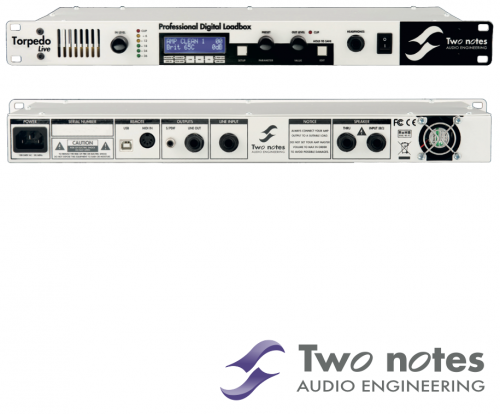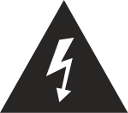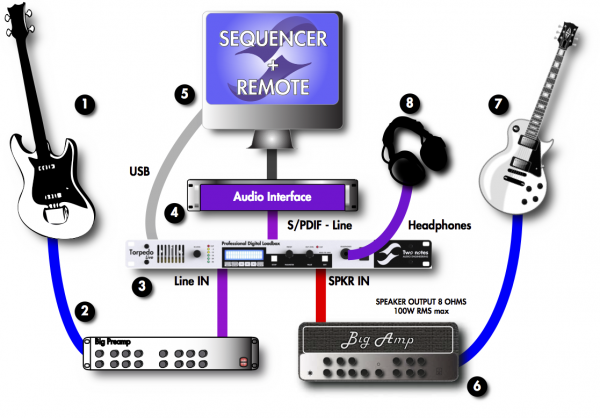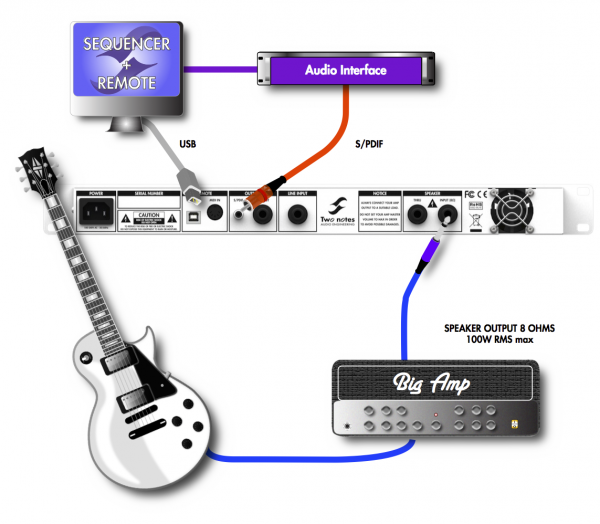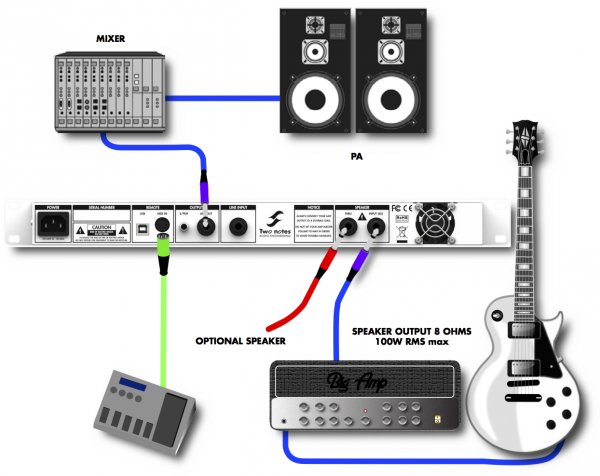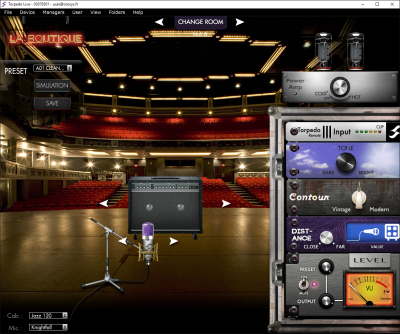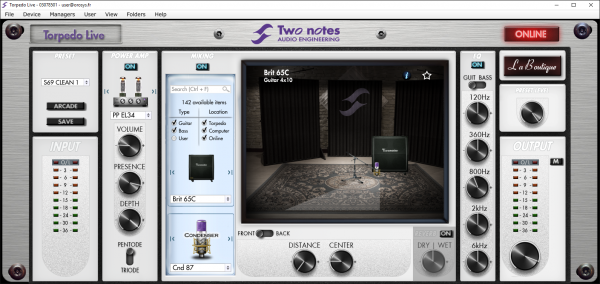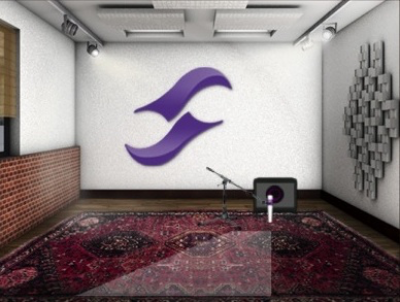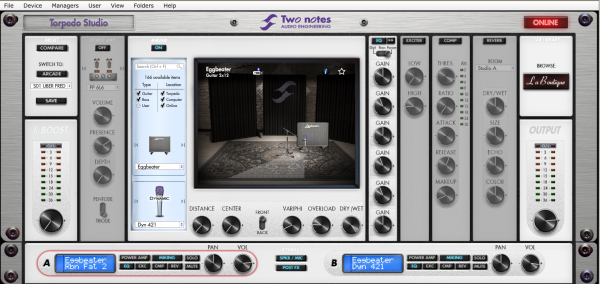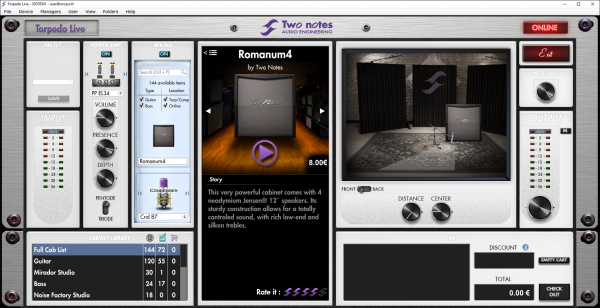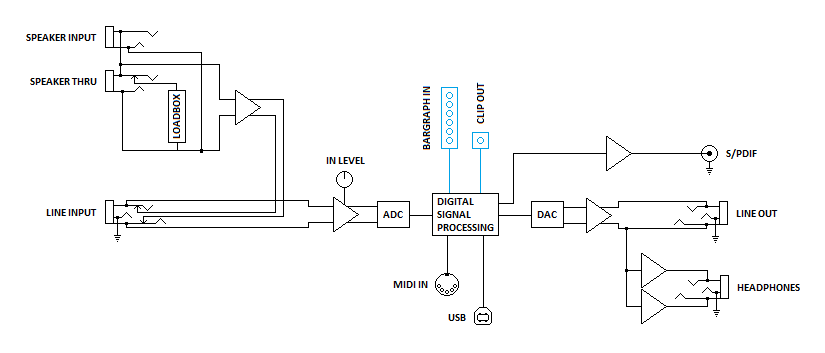- en
- fr
Torpedo Live User's Manual
Professional digital loadbox
The complete electronic version of this manual, as well as the Two notes Audio Engineering software and hardware products, are subject to updates. You can download the most recent versions of the products on the Two notes Audio Engineering website.
This manual describes the Torpedo Live and provides instructions for its operation. It is highly recommended that you read this document before using the product. The contents of this manual have been thoroughly verified and it is believed, unless stated otherwise, to accurately describe the product at the time of shipment from the factory or download from our website.
Two notes Audio Engineering is a registered trademark of:
OROSYS SAS
76 rue de la Mine
34980 Saint-Gély-du-Fesc
France
Tel: +33 (0)484 250 910
Fax: +33 (0)467 595 703
Contact and support: http://support.two-notes.com
Website: http://www.two-notes.com
This document is the exclusive property of OROSYS SAS. In the interest of product development, OROSYS SAS reserves the right to change technical specifications, modify and/or cease production without prior notice. OROSYS SAS cannot be held responsible for any damage, accidental or otherwise, that results from an inappropriate use of the Torpedo Live. Please refer to the safety instructions included in this manual. The reproduction of any part of this document is strictly forbidden without the written authorization of OROSYS SAS.
All product names and trademarks are the property of their respective owners. Product names and trademarks found in this document were used during the development of the Torpedo Live product but are in no way associated or affiliated with OROSYS SAS.
Foreword
1. Safety instructions
Before using the product, it is necessary to carefully read and to bear in mind the following information. Keep this document in a safe place as it is important for the protection of both user and product. Should you suspect any malfunction of the device, always seek the assistance of a qualified technician.
1.1 Risk of electric shock
1.2 Reader warning
1.3 Mains power
Please verify that the voltage required by the unit matches the voltage of your country. If not or if unsure, don’t connect the unit to the wall outlet, this could result in damages to the unit and injuries to the user. This product must not be used when there is lightning. In case of severe weather with a risk of lightning, unplug the mains power supply to reduce the risk of electric shock and fire. The mains power cable provided with the unit complies with the standards of the country where you purchased the product. If replacement is needed, please use a standard compliant cable.
1.4 Ground connection
For safety reasons, the unit needs to be plugged to a wall outlet providing a ground connection. If your electric installation does not provide a ground connection or if you are unsure, please ask a qualified electrician for help.
If your mains power cable doesn't match your wall outlet, ask a qualified electrician for help. Never remove the outer or inner ground connection of the unit to prevent risks of electric shock or fire.
1.5 Safety use conditions
The Torpedo Live must never be used near a heat source, near a flame, in the rain, in damp areas, near any kinds of liquids. The unit is designed to be rackmounted into a 19“ rack unit with 4 screws (not provided). When transporting the unit, care needs to be taken to avoid any shocks that could cause damage that would require the assistance of a qualified technician. Never cover or restrict the ventilation openings. Never unplug or deactivate the heat control monitoring system, or you will be exposed to risk of electric shock and fire.
1.6 Cleaning
Always use a dry and soft cloth with no alcohol or solvents for cleaning. Please keep the unit clean and free from dust.
1.7 Maintenance
All maintenance operations must be done by service centers approved by OROSYS SAS or by qualified technicians. Never try to repair the unit by yourself.
2. Contents of the package
The shipped package contains:
- One Torpedo Live unit in a protecting sleeve
- One mains power cable
- One USB cable
- One owner’s manual
The complete electronic version of this manual, as well as the Torpedo Remote and Torpedo BlendIR softwares are subject to updates. You can download the most recent versions of these products on the Two notes Audio Engineering website.
3. Declaration of conformity
Manufacturer: OROSYS SAS
Category of product: digital audio signal processor
Product: Torpedo Live
Test Manager: Guillaume Pille
The Two notes Torpedo Live is certified to be compliant to the CE and FCC standards:
- EN 55103-1 : 1996 and EN 55103-2 : 1996.
- EN 60065 05/2002 + A1 05/2006.
- EMC directive 89/336/EEC and Low Voltage Directive 73/23/EEC.
- FCC Part 15 : 2008.
- ICES-003 : 2004.
- AS/NZS 3548 class B for Australia and New Zealand.
- IEC : 2008 - CISPR 22 class B.
4. Disposal of Waste Equipment by Users in Private Household in the European Union
5. Warranty
OROSYS SAS warrants that this TWO NOTES AUDIO ENGINEERING product shall be free of defects in parts and workmanship when used under normal operating conditions for a period of two (2) years from the date of purchase. This warranty shall apply to the original purchaser when purchased from an Authorized TWO NOTES AUDIO ENGINEERING dealer.
IMPORTANT: PLEASE RETAIN YOUR SALES RECEIPT, AS IT IS YOUR PROOF OF PURCHASE COVERING YOUR LIMITED WARRANTY. THIS LIMITED WARRANTY IS VOID WITHOUT YOUR SALES RECEIPT.
Defective products that qualify for coverage under this warranty will be repaired or replaced, (at OROSYS SAS's sole discretion) with a like or comparable product, without charge. In the case that warranty service is required, Please contact your authorized TWO NOTES AUDIO ENGINEERING dealer in order to obtain an RMA to return the complete product to the Authorized TWO NOTES AUDIO ENGINEERING Service Center closest to you, with proof of purchase, during the applicable warranty period.
Transportation costs to the service center ARE NOT INCLUDED in this limited warranty. OROSYS SAS will cover the cost of standard ground return transportation for repairs performed under this warranty. This limited warranty becomes void if the serial number on the product is defaced or removed, or the product has been damaged by alteration, misuse including connection to faulty or unsuitable ancillary equipment, accident including lightning, water, fire, or neglect; or if repair has been attempted by persons not authorized by OROSYS SAS. Any implied warranties, including without limitation, any implied warranties of merchantability or fitness for any particular purpose, imposed under state or provincial law are limited to the duration of this limited warranty. Some states or provinces do not allow limitations on how long an implied warranty lasts, so the above limitations may not be applicable.
OROSYS SAS ASSUMES NO LIABILITY FOR PROPERTY DAMAGE RESULTING FROM ANY FAILURE OF THIS PRODUCT NOR ANY LOSS OF INCOME, SATISFACTION, OR DAMAGES ARISING FROM THE LOSS OF USE OF SAME DUE TO DEFECTS OR AVAILABILITY OF SAME DURING SERVICE.
In case you have to send your TWO NOTES AUDIO ENGINEERING product to any other location, it is of vital importance to retain the original packing materials. It is very difficult to avoid damage if shipping the product without these materials. OROSYS SAS is not responsible for damages to the product due to improper packaging and reserves the right to charge a reboxing fee for any unit returned for service without the original packing materials. THE FOREGOING CONSTITUTES THE ONLY WARRANTY MADE BY OROSYS SAS WITH RESPECT TO THE PRODUCTS AND IS MADE EXPRESSLY IN LIEU OF ALL OTHER WARRANTIES EXPRESSED OR IMPLIED
Recommendation on the proper use of a loadbox with a tube amplifier
1. What is a loadbox?
In the normal use of a tube amplifier, it is highly recommended that you always connect its power output to a speaker cabinet prior to powering it up. The speaker cabinet (4, 8 or 16 Ohms) must always be connected to the corresponding speaker output of your amplifier. Not doing so can lead to partial or complete destruction of the output stage of the tube amplifier.
Most tube amplifiers makers protect their products with fuses or other protection systems, however some amplifiers are still insufficiently protected. It is impossible to predict the behavior of all the amplifiers on the market in case of use without a load (a speaker cabinet or a loadbox).
The electronic term that describes the speaker cabinet with respect to the amplifier is the “load”: we say the cabinet “loads” the amplifier. The term “loadbox” is used to describe any product that provides a load to the amplifier. The main parameter of the loadbox is its impedance, expressed in Ohms. An 8-Ohm loadbox must be plugged to the 8-Ohm speaker output of the amplifier.
The power sent to the load is turned into heat, so please follow the cooling recommendation in the manual — otherwise overheating may cause damage, both to the loadbox and to the amplifier.
The Torpedo Live is a digital loadbox. This term indicates that the Torpedo Live is a load which can electrically replace the speaker cabinet while dissipating (transforming into heat) the power coming out of the amplifier.
Within the Torpedo Live is a Reactive load. A Reactive load simulates the complex impedance of a real speaker.
 | Always connect the speaker out of your tube amplifier to an appropriate load (speaker cabinet or loadbox). The Torpedo Live, once powered up, is such a load. Please note that you should always power up the Torpedo Live before your amplifier. The maximum admissible power of the Torpedo Live is 100W RMS, your amplifier shouldn't be set to play at a higher output power value. See this article if your amplifier is more powerful than 100W. | |
2. Which output volume for my amplifier?
The correct use of your amplifier with a loadbox requires some precautions. Because of the silence while playing, it is much easier to accidentally run your amplifier beyond the reasonable limits set by the manufacturer than when using a real speaker cabinet with it. This can lead to faster tube wear and, in some cases, to more serious inconveniences.
Keep in mind that the “sweet spot” - the perfect running point of the amplifier, the one that will give you the tone you’re looking for - is rarely obtained at maximum volume. In addition, the volume control of the amplifier is usually logarithmic, which means the volume goes up quickly on the first half of the potentiometer rotation, reaches its maximum at 12 o’clock, and doesn’t change much beyond this point. Therefore, you can reach the maximum volume of your amplifier even if the volume potentiometer is not set at maximum.
By reaching the maximum output power of your amplifier, you will hear a lot of distortion, which may not sound as well as you may hope. In fact, most amplifiers sound rather poorly at maximum volume. Always keep in mind that your amplifier may not have been conceived to be used at maximum volume for a long period of time. Running an amplifier at high volume will cause premature wear of the tubes and possible malfunctions or damages at the output stage.
3. Is the use of a loadbox totally silent?
We usually talk about “silent recording” when a loadbox is involved. If we compare the loadbox solution to a traditional cabinet miking solution, it is obviously A LOT quieter. Noises that you may have not been able to hear before due to the volume of the speaker cabinet will now be more apparent. Here are a few of those sounds that you might have to take into account:
• Your guitar or bass strings can be heard. If you are not used to this, it could be initially distracting, depending on your environment.
• You may hear some noise coming out of your Torpedo Live when playing, like there is a tiny speaker inside the box. This is perfectly normal and there is no reason to worry. The sound is produced when power goes through the coil of the reactive load embedded on the Torpedo Live. The vibration is related to what power comes out of the amplifier connected to the Torpedo Live and to the signal’s frequency content (notes played are heard). Your ampli- fier, specifically the output transformer of your amplifier, may also produce similar noise. Such noise is usually not heard, simply because it is normally obscured by the sound coming from the loudspeaker.
• The Torpedo Live has a built in fan, as there is quite a lot of power dissipated into heat inside the box. We selected a so called “silent fan”, but as it is running fast, it is never entirely silent. This said, you can consider that, in normal use (hearing your guitar through monitors, or headphones), you can barely hear the fan.
About the Torpedo Live
1. Introducing the Torpedo Live
Two notes Audio Engineering is proud to introduce the Torpedo Live, the optimized for live playing version of the critically-acclaimed Torpedo hardware series. This product has been developed through years of technical research, with great attention to the needs of guitarists, bassists and sound technicians confronted with the challenges of miking instrument amplifiers, on stage or in the studio. Our goal is to provide ease of use, reliability, versatility and above all, perfect audio quality.
The Torpedo technology was created as an answer to the high pressure musicians have to deal with: lack of time, limited gear availability, loud amplifiers that can’t be played at desired volume, as well as bulky and heavy cabinets to carry. In addition, many musicians are more comfortable with their analog amplifier and effect pedals, and don’t want to perform using digital modeling systems, which may compromise their playing style and sound.
For them, the Torpedo Live offers a “virtual” alternative to traditional miking, using a technology derived from the convolution reverberation, to achieve a degree of realism never experienced previously with simulators. The musician simply plugs the Torpedo Live in place of his cabinet, connected to the speaker output of his amplifier, without modifying his usual settings (or connected effect pedals as applicable).
The Torpedo Live comes with a large library of 32 cabinets and 8 microphones among the most commonly used models in the world. You can also upgrade and add many other cabinets through “La Boutique”, our online virtual cabinet store.The virtual miking is achieved by choosing one cabinet and one microphone, and fine-tuning the position of the microphone in front of the cabinet. The Torpedo Live allows the user to assume the role of the sound engineer in a professional studio.
The Torpedo Technology: to bring you realism and playing comfort, Two notes has developed a unique technology based on an adaptation of convolution techniques. Starting with the measurement of an actual cabinet + microphone setup, the Torpedo Live can accurately reproduce the system as it was measured, as well as the microphone’s position in space. In order to take full advantage of these digital algorithms, the highestquality audio design assures a perfect analog-to-digital conversion and a huge dynamic range to retain the ultimate playing experience.
This product has been thoroughly tested in professional studio and stage environments and is the alternative many musicians were waiting for, to achieve a professional sound capture of their amplified instruments. The Torpedo Live will give you the elusive sound of the greatest recording studios and producers, anytime, anywhere.
2. Front panel
1. Ventilation slit
2. Input gain
3. Display
4. SETUP button
5. PRESET/PARAMETER encoder
6. OUT LEVEL/VALUE encoder
7. EDIT/SAVE button
8. Phones output
9. Mains switch
3. Rear panel
1. Mains power
2. Serial number
3. USB
4. MIDI
5. S/PDIF In/Out
6. Balanced line output
7. Balanced line input
8. 8 Ohms load warning
9. Speaker output
10. Amplifier input
11. Fan
4. Only A Speaker Simulator?
The Torpedo Live is a standalone unit you can bring with you in any situation, whenever silent playing is needed.
The role of the Torpedo Live is to replace the following elements of the traditional guitar or bass setup:
- the guitar/bass power amplifier
- the speaker cabinet
- the microphone
- the microphone preamplifier
In order to provide a signal that is the closest possible to a traditional guitar/bass miking in a professional studio environment.
The miking is achieved in 3 steps with the Torpedo Live:
- Choose a power amplifier (or switch it off if you are using a loadbox), a speaker cabinet and a microphone (Power Amp, Speaker, and Microphone sections)
- Position the microphone inside the virtual studio (Miking window and parameters)
- Shape the signal (EQ, Reverb sections)
At each step, Two notes Audio Engineering implements its know-how to offer the most advanced simulations on the market and ensure absolutely realistic quality both for the musician (in terms of playing sensation) and for the listener (in terms of sound quality). You can load up to 32 Two notes cabinets in the Torpedo Live. Download the free Torpedo Remote software (Mac OS X and Windows PC) from the Two notes Audio Engineering website, and you will be able to add or remove the stored cabinets. There are currently more than 80 Two notes cabinets available in La Boutique and the Two notes Store that you can try in real time and purchase with Torpedo Remote (requires a working Internet connection).
4.1 Tube Stage Output
When using guitar/bass preamplifiers with some other speaker emulators, the musician may feel they miss a power amplifier’s contribution to the overall sonic texture. Many musicians get their sound from a particular use of that element and the Torpedo Live gives you the possibility to use it too. To that effect, Two notes Audio Engineering has developed an original tube-stage modeling that gives you a choice of 4 different tube models (6L6, EL34, EL84 and KT88) in Push-Pull (PP) in AB class, or Single Ended (SE) in A class configurations. You can push this tube stage like a conventional amplifier and look for that subtle yet particular distortion.
The Torpedo Live can be used as a super-DI for keyboards. The tube-amp simulation feature, developed for guitarists and bassists, can also be a very interesting device to warm up the sound of a synthesizer, an organ, or a digital piano.
4.2 EQ Section
When recording guitars or basses, it is common to apply a few effects to shape the sound before sending it to a PA or a recorder. In the Torpedo Live you will find a simple but efficient EQ filter with two modes, GUITAR or BASS.
4.3 Room reverb
One of the latest additions to our Torpedo firmware is a room reverb. When recording a guitar or a bass, the room sound is really important, especially with distant miking. With the Torpedo Live, you get the option to choose how the record room sounds!
4.4 The Torpedo technology, convolution and Impulse Responses
The impulse response (IR) of a system describes its behavior under the form of a very detailed filter. The convolution technique uses IRs to simulate the behavior of particular systems, such as reverbs, speakers, EQ…
It is the most accurate way to simulate sound signatures that are linear (i.e. without distortion) and timeinvariant (i.e. without modulation, compression, hysteresis…). It is particularly well suited for speaker miking simulation.
| Two notes has developed a unique technology based on an adaptation of convolution techniques. Starting with a measure of a real cabinet + microphone setup, the Torpedo Live can accurately reproduce the system as it was measured, including the microphone’s position in space by using IR synthesis. |
4.5 3rd Party Impulse Responses
The Torpedo Live is capable of delivering the best guitar and bass tones by using the Torpedo technology, but you can also embed impulse responses that you have purchased or downloaded for free from 3rd-party developers, in WAV or AIFF formats. You can upload third-party IRs in the Torpedo Live, by way of the free Torpedo Remote software.
4.6 Create Your Own IR's
Download the free Torpedo BlendIR software from the Two notes Audio Engineering website. With this software you will be able to capture your own cabinet + microphone setup and embed its sound signature into the Torpedo Live.
Connecting the Torpedo Live
1. Overview
The Torpedo Live offers a solution for silent and quality sound pick-up in many situations. The following illustrations show the most common situations theTorpedo Live has been created for.
1. Guitar/bass
2. Guitar/bass preamp
3. Torpedo Live
4. Audio interface
5. PC/MAC with Torpedo Remote
6. Guitar/bass amp
7. Guitar/bass
8. Headphones
Even if it was design to go on stage, the Torpedo Live fits perfectly in a digital or analog studio, to bring you the greatest tone with your amp, whatever the circumstances.
 | Please keep in mind that tube amplifiers have to be connected to an appropriate load (cabinet or load box). Always plug the 8 ohms output from your amp to the 8 ohms input of the Torpedo Live. |
2. In the studio
The studio setup shown here is an integration of the Torpedo Live in a usual Digital Audio Workstation.
Plug your 8 ohms out on your amplifier to the SPEAKER input of the Torpedo Live. If you want to use a preamplifier, plug its line output to the LINE INPUT of the machine. Connect the S/PDIF OUT of the Torpedo Live to the S/PDIF IN of your audio interface. The sampling frequency can be set to 48KHz or 96KHz.
In this configuration the Torpedo Live is the master of the S/PDIF communication. This way, analog to digital conversion is handle by the Torpedo Live, so you preserve all the tone coming from your preamp/amp.
An S/PDIF signal contains two audio channels. The Torpedo Live is a mono unit, so we decided to give a great feature : sending the WET signal (with miking simulation) through the LEFT channel and the DRY signal (without miking simulation) on the RIGHT. This way you can record the dry and wet signal simultaneously. Use the Wet signal to play as usual, and the DRY signal from the amp with a plugin speaker simulator, such as our Torpedo WoS III plugin. You can decide to use both channels to carry the Wet or the Dry signal, please read about the Output parameter in the Setup menu.
Control the machine from your computer (PC Windows or Mac OSX) with the Torpedo Remote software in USB. Create, save and load presets, load new cabinets or Impulse Response (IR) files. Download the Torpedo Remote for free on the Two notes Audio Engineering website.
3. On stage
The analog I/O of the Torpedo Live offers great options on stage. For example, the analog output can be connected to the front mixing console. Or plug headphones to the appropriate output and enjoy playing your amp LOUD at home in total silence.
In the following figure, you will find a simple setup with an amplifier. The same can be done with a preamplifier into the LINE INPUT of the Torpedo Live.
With a MIDI foot controller, you gain access to the presets navigation and even parameter changing in real time. The Torpedo Live handles both Program Change et Control Change commands.
Playing in silence is a great feature, but at some point you have to listen to what you play! We present a few options to use at home, in the studio or on stage:
- Listen through the headphones out,
- Listen on a guitar/bass cabinet plugged to the Torpedo Live THRU output,
- Having a local monitoring system on stage, by duplicating the LINE OUPUT with a mixer,
- Having in-ear monitors or wedge speakers controlled by a sound engineer.
4. Stay connected
You may have discovered an idea to use the device in some innovative way. Do not hesitate to come and share your experience on the Two notes Audio Engineering Forum or social networks. Please go to the Two notes Audio Engineering website and click on the “Community” section.
Two notes is also on the social networks Facebook, Soundcloud and Youtube — so do not wait and come share your creative work!
Configuring and using the Torpedo Live
1. The Torpedo Live interface
The Torpedo Live parameters are organized in menus, accessible by different push-buttons and knobs as seen in figure 3.2.
- Two 2-function rotary encoders: PRESET/PARAMETER, OUTPUT LEVEL/VALUE
- Two push-buttons: SETUP and EDIT/HOLD TO SAVE.
- One potentiometer: IN LEVEL.
When pushing a button or turning an encoder, you will see a parameter moving on the display.
2. Input gain control
The IN LEVEL potentiometer controls the input gain of the unit. The Torpedo Live being a digital product, it is absolutely critical to avoid any saturation of the input signal and avoid the risk of considerably reducing the audio quality. The input level is controlled by a potentiometer and is the same for all presets. To get the best sound, try to have the same volume (or close) on all different sounds coming to the Torpedo Live. This way you won’t have to change the input gain when switching the channels on your amplifier. If you don’t have individual volume settings on your amplifier channels, always do the gain setting with the loudest channel.
The input gain adjustment must be done with input signal present at the input selected (speaker or line input). The input bargraph gives you a visual indication of the input signal amplitude. The upper red led is on when there is saturation in the input stage: lower the volume of your amplifier output and/or lower the input gain.
3. Three menus: PERFORM, EDIT & SETUP
The Torpedo Live has three different menus, giving you access to different parameters:
- Navigate through the 128 presets in PERFORM menu
- Edit a preset in EDIT menu
- Setup global parameters of the unit in SETUP menu
To enter a menu, whatever the current menu, push the appropriate button. To see and modify the various parameters, use the appropriate encoders which function depends on the current menu.
4. PERFORM
The PERFORM menu is the default menu you will see when first using the Torpedo Live. The following information will be displayed on the screen:
- First line: preset name, preset type (Arcade or Simulation) and number (between 001 and 128.)
- Second line: Cabinet name (or IR name) and output volume (OUT LEVEL between -95dB and +12dB).
In this menu you can navigate in the presets and set the output volume of the unit. You will be in this menu when playing without editing or modifying any parameter. This way you can have a fast access to the volume in case you have to quickly lower or increase the volume in any situation.
We recommend first to search for a preset close to the sound you have in mind, then tweak the selected.
 | The preset name is limited to 32 letters or numbers. The authorized characters are capital A to Z, 0 to 9 and space. |
The various functions of the buttons in PERFORM menu are described in the following table:
| Button | Function |
|---|---|
| SETUP | Switch to SETUP menu |
| PRESET/PARAMETER | Navigate the presets |
| OUT LEVEL/VALUE | Set the output volume |
| HOLD TO SAVE/EDIT (hold) | Save a preset |
| HOLD TO SAVE/EDIT (toggle) | Switch to EDIT menu |
5. EDIT
In the EDIT menu, you will have access to all the parameters of a preset. You can choose between two preset modes: Arcade or Simulation. We borrowed the concept of Arcade VS Simulation from the world of video games.
The Arcade mode is usually the easy way to, for example, drive a race car. You can hit obstacles, other cars, you can still win the race. We recommend that for your first experience with The Torpedo Live you start with the Arcade preset mode to get more familiar with the concept of virtual miking.
The simulation mode is not for beginners and requires more experience and knowledge about how the car actually works, depending on many tiny but still important parameters (weather, type of tires, track design…). In that preset mode you will gain access to the full list of parameter, to fine tune your sound and make it perfect to your ears.
The various functions of the buttons in EDIT menu are described in the following table:
| Button | Function |
|---|---|
| SETUP | Switch to SETUP menu |
| PRESET/PARAMETER | Navigate the parameters |
| OUT LEVEL/VALUE | Modify the selected parameter |
| HOLD TO SAVE/EDIT | Save a preset between |
| HOLD TO SAVE/EDIT | Switch to PERFORM menu |
5.1 Arcade mode
In Arcade mode, the EDIT menu displays all the Arcade parameters, followed by the output volume of the preset (this volume setting is saved with the preset, so you can adjust the levels in order for the presets to be at comparable volumes).
Navigate through the parameters with the PARAMETER encoder. On a parameter page, you will see the name of the parameter and its value. Change the value using the VALUE encoder.
In the simplified interface of the Arcade mode, each parameter actually controls one or several parameters of the Simulation mode. For more details on the Simulation mode, see its description later in this document.
The parameters of the Arcade mode are listed below:
- Instrument: Guitar or Bass, determine the type of speaker cabinet you can access and select later, the power amp type and parameters and EQ characteristics of the Contour parameter.
- Speaker: Pick a speaker cabinet in the list, the list depends on the Instrument parameter and the cabinets you actually loaded into you product’s memory.
- Mic: Select a microphone in the list.
- Room: Select one of the 8 rooms.
- Power amp: In Guitar mode we selected an EL34 Pentode PP power amp and a 6L6 Pentode PP power amp for Bass. Presence and Depth are fixed at 100%. The Power amp parameter determine the amp master volume, from Cold to Hot. it can also be turned OFF.
- Distance: In Arcade mode, Distance triggers both the mic placement algorithm (IR synthesis) and the Dry/Wet of the Reverb. The farther the microphone is from the cabinet, the more you will hear the reverb effect. The microphone is always in front of the cabinet.
- Tone: Miking tone, from Dark to Bright. Triggers the Center parameter, moving the microphone from the center of the speaker to the side.
- Contour: EQ settings based on a loudness algorithm. Vintage will cut low and high frequencies while Modern will emphasize them. The EQ parameters depends on the Guitar/Bass setting.
- Level: Controls the level of the preset, from -95dB to 0dB.
5.2 Simulation mode
In Simulation mode, the EDIT menu features 4 modules (Power Amp, Miking, EQ and Reverb), followed by the output volume of the preset (this volume setting is saved with the preset, so you can adjust the levels in order for the presets to be at comparable volumes). Navigate through the parameters and/or modules with the PARAMETER encoder.
A module is activated when it’s On, you can change the module state with the VALUE encoder. Once the module is On, you gain access to the module parameters.
On a parameter page, you will see on the first line the module name, the parameter index and the number of parameters of the module. On the second line you will find the parameter name and its value. Change the value using the VALUE encoder.
5.2.1 Power Amp
When using the Torpedo Live with any kind of guitar/bass preamplifier, or even an electric piano or a synthesizer, you need the color brought by the final stage of a traditional amplifier: the power amplifier. Plug your device to the LINE input of the Torpedo Live and enjoy the typical sound of the Two notes electrically accurate virtual tube power amplifier:
- Power Amp: Activate the power amplifier simulation by turning “On” this parameter.
- Model: Choose the amplifier topology (Push Pull or Single Ended) and the tubes type (6L6, EL34, EL84 or KT88).
- Volume: Set up the output volume of your virtual power amplifier.
- Presence: This setting affects the tube stage frequency (loudness).
- Depth: This setting affects the tube stage frequency (bandwidth).
- Type: Select how the tube is used, either in triode or in pentode mode. Pentode mode has more headroom and volume than triode.
5.2.2 Miking
In the “MIKING” menu, you take the place of the sound engineer. This is where you will find the “sweet spot”, the perfect microphone position.
You have the option to choose whether you want to use the Two notes cabinets and microphones combinations (Cab/mic) or a third party IR (User) selected from the installed IR’s in one of the 4 available User banks (of up to 128 files each).
In Cab/mic mode, you have access to 32 different cabinets, each cabinet can be miked with 1 of the 8 available microphones. Please refer to Part 7 to discover the microphones and cabinets library. The 32 cabinets that you will find offer the same list of 8 microphones, but you will discover that the cabinets offered by the Capture Masters in La Boutique can offer a different set of microphones, to expand the versatility of your Torpedo.
The next step is to place the microphone on the trapezoidal plan (you can see it in the Torpedo Remote interface):
- Distance: Determine the distance between the simulated cabinet and microphone. Placing a microphone close to the cabinet will result in a precise sound with a large amount of proximity effect (dependent on the chosen model of microphone). When you move the microphone away from the cabinet, you increase the proportion of the studio’s acoustics (early reflections) in the overall sound. Furthermore, depending on the cabinet model used, and especially with the ones with multiple speakers, moving the microphone away can bring some higher frequencies back. This is simply due to the directivity of the loudspeakers. At the maximum position (100%), the microphone is placed 3 meters (10 feet) away from the cabinet.
- Center: Determine the distance between the axis of the loudspeaker and the microphone (placed at right angle). The on-axis position (0%) allows the maximum amount of treble frequencies which are highly directional. Moving the microphone away from the axis decreases the treble, resulting in an enhancement of bass response. At maximum position (100%), the microphone is placed at the edge of the speaker when Distance is 0%, and 1 meter (3 feet) away from the axis when Distance is 100%.
- Position: in standard sound capture, the microphone is usually placed in front of the cabinet. However, placing the microphone behind the cabinet can be quite interesting. The sound is usually softer and darker. This is particularly obvious with closed cabinet, less with open ones.
5.2.3 EQ
This is a simple yet powerful 5-band EQ. Changing the mode (guitar or bass) shifts the band frequencies to focus on the interesting signal frequencies for the corresponding instrument.
- EQ: Activate the EQ filter.
- Mode: Guitar or Bass, EQ presets to fit the center frequencies with the instrument you play.
- 120Hz, 360Hz, 800Hz, 2000Hz, 6000Hz (Guitar mode): center frequency of each band, from the lower to the higher. The frequencies depend on the mode, Guitar or Bass. You can adjust the level in dB of each band.
- 50Hz, 120Hz, 360Hz, 800Hz, 4000Hz (Bass mode): center frequency of each band, from the lowest to the highest. You can adjust the gain, measured in dB, of each band.
5.2.4 Reverb
To enhance you experience with the Torpedo Live, especially when playing with headphones, your unit features a room reverb.
- Room: The room type determines the type of reverb you will apply to your guitar or bass tone. You have access to 8 different rooms: Studio A & B, Hall A & B, Cathedral, Crypt, Basement and Loft.
- Dry/Wet: Determines the amount of reverb to be applied to you tone.
5.3 Which cabinet is the right one for me?
The Torpedo Live comes with 32 cabinets, for bass and guitar. Among these cabinets you will find some that you know, others that you should know, and maybe the hidden gem that will work for you and you had no idea. To work faster, you should make sure the EQ, reverb and anything apart the cabinet and microphone are turned off so you can concentrate on that part of the process.
Please try the cabinets without too much preconceived idea about what you think you need. Often, the solution comes from a cabinet you wouldn’t think of. As a general guide, we recommend using small sized cabinets for more mids and high frequency, they are good fo solos and clean tones. Use the big boys on distorted and/or or rhythm guitars.
5.4 Which microphone is the right one for that cabinet?
You will find a selection of 3 types of microphones with each Two notes cabinet: condenser, ribbon and dynamic. The microphone technology gives an idea on how it will sound, even if, with each technology, you could find microphones that are not sounding as you might expect.
- With the Torpedo Live, you will choose a ribbon microphone if you need a smooth, creamy tone. They are perfect when the guitar or the bass is in a light mix (meaning without tons of other instruments or distortion). We always recommend that type of microphone for the guitarist or bassist who is approaching miking techniques for the first time, they will sound very close to what you hear on your traditional guitar or bass cabinet.
- Condenser microphone usually give wide bandwidth and great details in the upper frequency. Very good on bright clean tones, they also excel at helping fit a distorted guitar in a mix.
- Dynamic microphones are what you usually find on stage because they are sturdy and reliable. They usually give good detail in the mids, but they are not as subtle as ribbon or condenser microphones.
Take the time to try them, and learn more about the different types of microphones to anticipate what you need, depending on your amp and cabinet tone, and of course the type of tone you aim at having on stage or in the studio.
6. SETUP menu
| Button | Function |
|---|---|
| SETUP | Return to PERFORM menu |
| PRESET/PARAMETER | Navigate the parameters |
| OUT LEVEL/VALUE | Set a parameter value |
| HOLD TO SAVE/EDIT (hold) | Save a preset |
| HOLD TO SAVE/EDIT (toggle) | Switch to EDIT menu |
Whether you are in EDIT or PERFORM menu, click on the SETUP button to enter the SETUP menu. The SETUP menu groups all the global parameters of the Torpedo Live. In this menu, you will be able to monitor information, such as the reception of a MIDI command or the syncing of the unit with the Torpedo Remote as well as the selection of desired settings and preferences.
| Parameter | Value |
|---|---|
| MIDI CC Control MIDI PC Program MIDI CHANNEL MIDI MONITOR | Control Change receive, On or Off Program Change receive, On or Off MIDI Channel selection, from 1 to 16 or ALL (the unit listens to all MIDI channels) Incoming MIDI command monitoring • “- -”: a command is received on a MIDI channel different from the one you selected for the unit. • “In”: a command is received on the channel you selected for the unit. |
| REMOTE MONITOR | • No Connection: no active USB connection • USB Connected: active USB connection • Remote connected: active USB connection, sync with the Torpedo remote |
| OUTPUT | The Torpedo Live is a mono unit, but the S/PDIF digital output carries 2 channels: the Wet (meaning with speaker simulation) or Dry (meaning without speaker simulation) signal, or a combination of the two. It is important to note that the LEFT S/PDIF channel and the Line/Headphones output of the Torpedo Live are fed by the same signal. In other words, when the LEFT S/PDIF channel carries the DRY signal, the Line and Headphones output will carry the DRY signal too. When the LEFT S/PDIF channel carries the WET signal, the Line and Headphones output carries the WET signal. |
| SPDIF Freq | Selection of the S/PDIF output frequency (48KHz or 96KHz) |
| Firmware Serial | Current firmware version of the unit Serial number of the unit |
7. MIDI setup
The MIDI parameters can be found on the SETUP menu. The Torpedo Live handles both preset change commands (Program Change or PC) and parameter change commands (Control Change or CC). This way, you can interact with all the parameters on the unit from any kind of standard MIDI controller, like a MIDI pedalboard or a keyboard.
- Select if the unit is to receive to Program Change and/or Control Change commands. For example, if you plan to use the preset switching (PC), the CC receive can be Off.
- Set a MIDI channel for the unit to receive. You can choose to receive all channels, which is useful when you don’t know exactly on which channel the commands are sent.
- With the MIDI monitor, check the correct reception of the commands by the Torpedo Live.
8. Continuous save, preset save
The state of the unit is saved in real time, continuously, and is reloaded when you switch on the unit. The parameters continuously saved are:
- the current preset,
- the modified preset if any (with all its parameters and name),
- the SETUP menu parameters,
- and the OUT LEVEL.
The navigation is not saved (for example if you were in a particular parameter menu). The purpose is to reload the unit at its initial state, after a power outage on stage, for example.
When you edit a preset, a star can be seen after the preset number in PERFORM menu. It is possible to navigate through the presets and to come back to the preset you are editing. This way, the modified and the non-modified preset can be compared. If you edit a second preset, this will cancel the modification on the first edited preset if it was not saved. It is only possible to edit one preset at a time.
Saving a preset can be done from any menu, by holding the HOLD TO SAVE/EDIT button. The saving process is done in three steps:
- “Rename & hold…“: Choose the preset name, use PARAM to change the character position and VALUE change the character. Hold the button to go to the next step.
- “Hold to save to:“: Choose where you want to save the preset, the default slot is the current one. Hold the button to go to the next step.
- You will see on the screen “Saving, please wait…“ for less than a second, the preset is now saved.
9. Torpedo Remote
You can add new cabinets or IR files to your Torpedo Live by using the standalone application Torpedo Remote for Windows™ and MAC OSX™, which you can download from the Two notes Audio Engineering website. Take control of the unit via USB, change the parameters, arrange or add/delete cabinets and IR files, and apply updates. Torpedo Remote will detect any new update or new Two notes cabinets (it requires a working Internet connection).
With Torpedo Remote you will be able to:
- Control the Torpedo Live with a USB link,
- Update the Torpedo Live's firmware,
- Manage and upload new Two notes virtual cabinets files or any third-party file,
- Manage, upload and download the presets.
The installation process of the Torpedo Remote software creates a folder where the Two notes virtual cabinets are stored :
- “Program Files\Two Notes Audio Engineering\Cabinets” on Windows™ (32bits)
- “Program Files (x86)\Two Notes Audio Engineering\Cabinets” on Windows™ (64bits)
- ”/Library/Application Support/Two Notes Audio Engineering/Cabinets” on MAC OSX™
Torpedo Remote automatically downloads and saves the Two notes virtual cabinets in this folder.
A second folder is created, where the 3rd party Impulse Responses are stored by default:
- “Program Files\Two Notes Audio Engineering\Impulses” sur Windows™ (32bits).
- “Program Files (x86)\Two Notes Audio Engineering\Impulses” sur Windows™ (64bits).
- ”/Library/Application Support/Two Notes Audio Engineering/Impulses” sur MAC OSX™.
You can store your IR files in this folder, or change the path of the folder in the interface of Torpedo Remote.
To load a Two notes virtual cabinet, a .tur file or a 3rd party IR in the Torpedo, use the Memory Manager of Torpedo Remote.
A third folder is created, where the presets are stored by default:
- “Program Files\Two Notes Audio Engineering\Presets” sur Windows™ (32bits).
- “Program Files (x86)\Two Notes Audio Engineering\Presets” sur Windows™ (64bits).
- ”/Library/Application Support/Two Notes Audio Engineering/Presets” sur MAC OSX™.
10. Want more cabs?
10.1 Two notes cabinets
Torpedo Remote features the new Two notes Boutique. This is an online store that gives you access to all of the Two notes virtual cabinets, captured with a set of 8 microphones. Make sure you have a working Internet connection and click on La Boutique.
On the bottom left you find all of the cabinet collections, which are simple filters: selecting a collection lets you see only the cabinets you may have an interest in. For example only bass or vintage cabinets.
On the center panel you can:
- browse the cabinets,
- launch a real-time preview of the cabinet by pressing the “play” button,
- get a closer look at the cabinet.
When previewing a cabinet, you can move the microphone while playing any track so as to listen to the tone of that particular cabinet. Please note La Boutique has some limitations:
- EQ and reverb are inactive.
- Short silences are randomly inserted into the audio process.
On the bottom right side of the Boutique interface you will find the cart. By pressing the “ADD” button on the cabinet panel, you will see the selected cabinet(s) appear on that panel. Depending on how many cabinets you wish to buy, you can get a discount. E.g., with more than 50 cabinets at a time, you get the biggest -65% “PROFESSIONAL” discount. Once you have put all the cabinets you need in you basket, simply click on “Check out” to be redirected to the Two notes Store. The secured payment process uses your Internet Browser. No billing or information on the payment method is stored on the Remote, so as to ensure maximum security.
10.2 .tur files
.tur are proprietary files created with the Two notes Audio Engineering Torpedo BlendIR software. The software is available for download from the Two notes Audio Engineering website. With Torpedo BlendIR you are able to use the Torpedo technology to capture the sound signature of your own cabinet and microphone in the deepest details.
To load a file into the Torpedo, place it in the default Impulse directory, or select the directory containing the files through Torpedo Remote (this can be done in the menu). You can then load the files into the Torpedo through the Memory Manager or directly listen to them through the main Remote window.
Please note that with .tur files you do not have access to the microphone positioning parameter.
10.3 3rd-party IR files (in .wav or .aiff format)
Torpedo Live complies with third-party Impulse Responses (IRs) in .wav or .aiff format.
To load a file into the Torpedo, place it in the default Impulse directory, or select the directory containing the files through Torpedo Remote (this can be done in the menu). You can then load the files into the Torpedo through the Memory Manager or directly listen to them through the main Remote window.
Note: with 3rd-party files you do not have access to microphone positioning parameters.
MIDI
Your Torpedo Live can receive MIDI Program Change (PC) and Control change (CC) commands sent by any kind of MIDI controller connected to the MIDI IN of the machine.
1. Program Change (PC)
Each preset on the Torpedo Live has a single program number. The preset 001 of the machine is triggered by a MIDI PC 1, you can address the 128 presets, with MIDI PC 1 to MIDI PC 128. This way, it is possible to randomly access the preset by sending the appropriate MIDI PC number.
2. Control change (CC) - For V3 firmware
The following table indicates the Control Change numbers for every parameter, as well as their range and behavior. This table is valid for firmware version 3.
| Parameter | CC# | Range | Behavior |
|---|---|---|---|
| Simulation mode | |||
| Power Amp | |||
| On/Off | 0 | 0-1 | 0 = Off ; 1 = On |
| Model | 1 | 0-7 | 0 = Model #0 ; 1 = Model #1… |
| Volume | 2 | 0-30 | 0 = 0dB ; 30 = 30dB |
| Presence | 3 | 0-127 | 0 = 0% ; 63 = 50% ; 127 = 100% |
| Depth | 4 | 0-127 | 0 = 0% ; 63 = 50% ; 127 = 100% |
| Type | 5 | 0-1 | 0 = Triode : 1 = Pentode |
| Miking | |||
| On/Off | 6 | 0-1 | 0 = Off ; 1 = On |
| Mode | 7 | 0-7 | 0 = Cab/Mic ; 1 = User 0 ; 2 = User 2 ; 3 = User 2 ; 4 = User 3 |
| Cab | 8 | 0-x | 0 = Cab #0 ; 1 = Cab #1… |
| User 0 | 9 | 0-x | 0 = File #0 ; 1 = File #1… |
| User 1 | 10 | 0-x | 0 = File #0 ; 1 = File #1… |
| User 2 | 11 | 0-x | 0 = File #0 ; 1 = File #1… |
| User 3 | 12 | 0-x | 0 = File #0 ; 1 = File #1… |
| Mic | 13 | 0-7 | 0 = Mic #1 ; 1 = Mic #1… |
| Distance | 14 | 0-127 | 0 = 0% ; 63 = 50% ; 127 = 100% |
| Center | 15 | 0-127 | 0 = 0% ; 63 = 50% ; 127 = 100% |
| Position | 16 | 0-1 | 0 = Back : 1 = Front |
| EQ | |||
| On/Off | 17 | 0-1 | 0 = Off ; 1 = On |
| Mode | 18 | 0-1 | 0 = Guitar : 1 = Bass |
| Low | 19 | 0-40 | 0 = -20dB ; 20 = 0dB ; 40 = 20dB |
| Low Mid | 20 | 0-40 | 0 = -20dB ; 20 = 0dB ; 40 = 20dB |
| Mid | 21 | 0-40 | 0 = -20dB ; 20 = 0dB ; 40 = 20dB |
| High Mid | 22 | 0-40 | 0 = -20dB ; 20 = 0dB ; 40 = 20dB |
| High | 23 | 0-40 | 0 = -20dB ; 20 = 0dB ; 40 = 20dB |
| Level | |||
| Preset Level | 24 | 0-95 | 0 = -95dB ; 95 = 0dB |
| Reverb | |||
| On/Off | 25 | 0-1 | 0 = Off ; 1 = On |
| Room | 26 | 0-7 | 0 = Room #0 ; 1 = Room #1… |
| Dry/Wet | 27 | 0-127 | 0 = 0% ; 63 = 50% ; 127 = 100% |
| Arcade mode | |||
| Instrument | 28 | 0-1 | 0 = Guitar ; 1 = Bass |
| Cab | 8 | 0-x | 0 = Cab #0 ; 1 = Cab #1… |
| Mic | 13 | 0-7 | 0 = Mic #1 ; 1 = Mic #1… |
| Room | 26 | 0-7 | 0 = Room #0 ; 1 = Room #1… |
| Power Amp | 29 | 0-30 | 0 = Off ; 1 = min ; 30 = max |
| Distance | 30 | 0-44 | 0 = min ; 44 = max |
| Tone | 31 | 0-44 | 0 = min ; 44 = max |
| Contour | 32 | 0-40 | 0 = min ; 40 = max |
| Preset Level | 33 | 0-95 | 0 = -95dB ; 95 = 0dB |
| General | |||
| Preset mode | 34 | 0-1 | 0 = Simulation ; 1 = Arcade |
| Out Level | 35 | 0-95 | 0 = -95dB ; 95 = 0dB ; 107 = 12dB |
| Mute | 36 | 0-1 | 0 = No mute ; 1 = Mute |
3. Control change (CC) - For V4 firmware
The following table indicates the Control Change numbers for every parameter, as well as their range and behavior. This table is valid for firmware version 4.
| Parameter | CC# | Range | Behavior |
|---|---|---|---|
| Simulation & IR Loader modes | |||
| Power Amp | |||
| On/Off | 0 | 0-1 | 0 = Off ; 1 = On |
| Model | 1 | 0-7 | 0 = Model #0 ; 1 = Model #1… |
| Volume | 2 | 0-30 | 0 = 0dB ; 30 = 30dB |
| Presence | 3 | 0-127 | 0 = 0% ; 63 = 50% ; 127 = 100% |
| Depth | 4 | 0-127 | 0 = 0% ; 63 = 50% ; 127 = 100% |
| Type | 5 | 0-1 | 0 = Triode : 1 = Pentode |
| Miking | |||
| On/Off | 6 | 0-1 | 0 = Off ; 1 = On |
| Cab | 8 | 0-x | 0 = Cab #0 ; 1 = Cab #1… |
| File A | 9 | 0-x | 0 = File #0 ; 1 = File #1… |
| File B | 10 | 0-x | 0 = File #0 ; 1 = File #1… |
| Folder A | 11 | 0-3 | 0= User 0 ; 1= User1; 2 = User 2 ; 3 = User 3 |
| Folder B | 12 | 0-3 | 0= User 0 ; 1= User1; 2 = User 2 ; 3 = User 3 |
| Mic A | 13 | 0-7 | 0 = Mic #1 ; 1 = Mic #1… |
| Distance A | 14 | 0-127 | 0 = 0% ; 63 = 50% ; 127 = 100% |
| Center A | 15 | 0-127 | 0 = 0% ; 63 = 50% ; 127 = 100% |
| Position A | 16 | 0-1 | 0 = Back : 1 = Front |
| Level A | 35 | 0-107 | 0 = -95dB ; 95 = 0dB ; 107 = 12dB |
| Phase A | 36 | 0-1 | 0 = Normal ; 1 = Invert |
| Mute A | 37 | 0-1 | 0 = Off (no mute) ; 1 = On (mute) |
| Mic B | 38 | 0-7 | 0 = Mic #1 ; 1 = Mic #1… |
| Distance B | 39 | 0-127 | 0 = 0% ; 63 = 50% ; 127 = 100% |
| Center B | 40 | 0-127 | 0 = 0% ; 63 = 50% ; 127 = 100% |
| Position B | 41 | 0-1 | 0 = Back : 1 = Front |
| Level B | 42 | 0-107 | 0 = -95dB ; 95 = 0dB ; 107 = 12dB |
| Phase B | 43 | 0-1 | 0 = Normal ; 1 = Invert |
| Mute B | 44 | 0-1 | 0 = Off (no mute) ; 1 = On (mute) |
| EQ | |||
| On/Off | 17 | 0-1 | 0 = Off ; 1 = On |
| Mode | 18 | 0-2 | 0 = Guitar : 1 = Bass ; 2 = Custom |
| Gain: Low | 19 | 0-40 | 0 = -20dB ; 20 = 0dB ; 40 = 20dB |
| Gain: Low Mid | 20 | 0-40 | 0 = -20dB ; 20 = 0dB ; 40 = 20dB |
| Gain: Mid | 21 | 0-40 | 0 = -20dB ; 20 = 0dB ; 40 = 20dB |
| Gain: High Mid | 22 | 0-40 | 0 = -20dB ; 20 = 0dB ; 40 = 20dB |
| Gain: High | 23 | 0-40 | 0 = -20dB ; 20 = 0dB ; 40 = 20dB |
| Freq: Low Cut | 45 | 0-127 | Specific mapping to Hz |
| Freq: Low | 46 | 0-127 | Specific mapping to Hz |
| Freq: Low Mid | 47 | 0-127 | Specific mapping to Hz |
| Freq: Mid | 48 | 0-127 | Specific mapping to Hz |
| Freq: High Mid | 49 | 0-127 | Specific mapping to Hz |
| Freq: High | 50 | 0-127 | Specific mapping to Hz |
| Level | |||
| Preset Level | 24 | 0-95 | 0 = -95dB ; 95 = 0dB |
| Reverb | |||
| On/Off | 25 | 0-1 | 0 = Off ; 1 = On |
| Room | 26 | 0-7 | 0 = Room #0 ; 1 = Room #1… |
| Dry/Wet | 27 | 0-127 | 0 = 0% ; 63 = 50% ; 127 = 100% |
| Arcade mode | |||
| Instrument | 28 | 0-1 | 0 = Guitar ; 1 = Bass |
| Cab | 8 | 0-x | 0 = Cab #0 ; 1 = Cab #1… |
| Mic | 13 | 0-7 | 0 = Mic #1 ; 1 = Mic #1… |
| Room | 26 | 0-7 | 0 = Room #0 ; 1 = Room #1… |
| Power Amp | 29 | 0-30 | 0 = Off ; 1 = min ; 30 = max |
| Distance | 30 | 0-44 | 0 = min ; 44 = max |
| Tone | 31 | 0-44 | 0 = min ; 44 = max |
| Contour | 32 | 0-40 | 0 = min ; 40 = max |
| Preset Level | 33 | 0-107 | 0 = -95dB ; 95 = 0dB ; 107 = 12dB |
| General | |||
| Preset mode | 34 | 0-2 | 0 = Simulation ; 1 = Arcade ; 2 = IR Loader |
| Out Level | 51 | 0-107 | 0 = -95dB ; 95 = 0dB ; 107 = 12dB |
| Mute | 52 | 0-1 | 0 = Off (no mute) ; 1 = On (mute) |
| Bypass | 53 | 0-1 | 0 = Bypass ; 1 = On |
| Preset | 54 | 0-127 | 0 = Preset #1 ; 1 = Preset #2… |
Specifications
1. List Of Power Amplifiers
| Designation | Characteristics |
|---|---|
| SE 6L6 | Configuration Single Ended - Class A with 6L6 |
| SE EL34 | Configuration Single Ended - Class A with EL34 |
| SE EL84 | Configuration Single Ended - Class A with EL84 |
| SE KT88 | Configuration Single Ended - Class A with KT88 |
| PP 6L6 | Configuration Push-Pull - Class AB with 6L6 |
| PP EL34 | Configuration Push-Pull - Class AB with EL34 |
| PP EL84 | Configuration Push-Pull - Class AB with EL84 |
| PP KT88 | Configuration Push-Pull - Class AB with KT88 |
2. List of cabinets
| Designation | Inspired by |
|---|---|
| GUITAR cabinets | |
| 2Notes CSG | Two Notes Custom 1×12” ElectroVoice® EVM12L |
| Angl VintC | Engl® 4×12” Celestion® V30 |
| Blonde 63 | Fender® Bassman ’63 Blonde Tolex Piggy Back 2×12“ |
| Brit 65C | Marshall® 1965A 4×10” Celestion® G10L-35 close back |
| Brit VintC | Marshall® Slash Signature 4×12“ Celestion® V30 close back |
| Calif StdC | Mesa/Boogie® Rectifier® Standard 4×12” Celestion® V30 close back |
| Eddie | Peavey® 5150 2×12“ Sheffield 1200 |
| Free Rock2 | VHT® Deliverance 2×12” Eminence® P50E |
| Green Tri | Hughes&Kettner® Triamp 4×12“ Celestion® Greenback |
| Jazz 120 | Vintage Roland® JC120 2×12” |
| JubilGreen | Marshall® 2550 2×12“ Celestion® Greenback |
| Kerozen | Diezel® 4×12” Celestion® V30 |
| Silver77 | Vintage Fender® Twin Reverb® 2×12“ orange JBL® |
| SilverJen | Vintage Fender® Twin Reverb® 2×12” Jensen® C12K |
| The One | Brunetti® Neo1512 1×15“ + 1×12” |
| Vibro Utah | Vintage 1961 Fender® Vibrolux® 1×12“ original Utah speaker |
| Vibro V30 | Vintage 1961 Fender® Vibrolux® 1×12” Celestion® V30 |
| Voice 30 | Original Vox® AC30 JMI 2×12“ Celestion® « Silver Bell » |
| Voice 65 | 1965 Vox® 2×12” |
| VoiceModrn | Vox® V212H, 2×12“ Celestion® Alnico Blue |
| Watt FanC | Hiwatt® 2×12” Fane close back |
| XTCab | Bogner® 4×12“ Celestion® V30 |
| BASS cabinets | |
| 2Notes CSB | Two Notes Custom 1×15” |
| Alu XL | Hartke® XL 4×12“ |
| AZ Ben | SWR® Big Ben 1×18” |
| AZ Work | SWR® WorkingMan 4×10“ |
| Calif Low | Mesa/Boogie® 2×10” |
| Fridge | Ampeg® 8×10“ |
| Heaven Bot | David Eden® 1×15” |
| Heaven Top | David Eden® 4×10“ |
| Marco | Markbass® 2×10” |
| Voice V125 | Vox® V125 2×12“ |
3. List of Microphones
This is the list of microphones provided with the virtual cabinets found in the memory of your Torpedo Live. If you buy other cabinets from the Two notes Store, you will find other microphones (more than a hundred models), depending on the selection made by the Capture Master who created the virtual cabinet.
| Designation | Inspired by |
|---|---|
| Dynamic 57 | Dynamic microphone Shure™ SM57 |
| Dynamic 421 | Dynamic microphone Sennheiser™ MD421 |
| Knightfall | Condenser microphone Blue™ Dragonfly |
| Condenser 87 | Condenser microphone Neumann™ U87 |
| Ribbon160 | Ribbon microphone Beyerdynamic™ M160N |
| Ribbon121 | Ribbon microphone Royer™ R121 |
| Bass 20 | Dynamic microphonee Electrovoice™ RE20 |
| Bass 5 | Dynamic microphone Shure™ Beta52 |
4. Block diagram
5. Technical Data
| Designation | Characteristics |
|---|---|
| Speaker Input | Jack 6.35 mm (1/4”) unbalanced (TS, Tip/Sleeve) Maximum input voltage: 280 V AC (51 dBu) Security load: 220 Ohms / 10 Watts |
| Line Input | Jack 6.35mm (1/4“) balanced (TRS, Tip/Ring/Sleeve) Maximum input level: 36 dBu Input impedance: 10 KOhms |
| Loadbox | Reactive Load, nominal impedance: 8 Ohms Maximum admissible power: 100W (assuming proper ventilation) (see this article if your amplifier is more powerful) Cooled by temperature-controlled fan High Impedance mode if a cabinet is connected to the THRU output (loadbox is disconnected). |
| Speaker Thru | Jack 6.35mm (1/4”) unbalanced (TS) |
| Line Output | Jack 6.35mm (1/4“) balanced (TRS) Impedance: 470 Ohms Maximum output level: • (no load, balanced): 16.5 dBu • (10k Ohms load, balanced): 16 dBu • (no load, unbalanced): 11 dBu • (10k Ohms load, unbalanced): 10.5 dBu |
| Headphones Output | MONO out, Jack 6.35mm (1/4”) balanced (TRS) |
| S/PDIF | Sampling frequency: 48 or 96 kHz Master only, no external synchronization Possibility to send Dry and/or Wet signal |
| ADC | Gain controlled by analogue potentiometer, -inf to 0dB Minimal full-scale input level: -2.8 dBu (Line Input) Sampling frequency: 96 KHz Resolution: 24 bits Signal to noise ratio: 100 dB |
| DAC | Sampling frequency: 96 kHz Resolution: 24 bits Noise level: -105 db |
| Frequency response (-1db) | 5 Hz - 19 kHz |
| Latency | 1.7 ms (Line Input to Line Output) |
| Thermal security | Temperature-controlled fan At 100°C, a visual warning is displayed and -12 dB attenuation is applied on the signal At 110°C, the loadbox is disconnected, the amplifier sees a 220 Ohms security load, and signal is muted. |
| Power supply | IEC60320 C14 power connector Input voltage: 85-264 V AC, 47-63 Hz Power: approx. 10 W |
| Dimensions | Width: 430mm, 483mm including rack-mounting edges Depth: 163mm, 182mm including connectors and knobs Height: 44mm Weight: 2 kg |
6. Connectors wiring
Technical support
Should you encounter a problem with your product or need help regarding any technical aspects, please note that Two notes Audio Engineering has developed on-line services to provide you with fast and efficient technical support, the Two notes Help Desk.
Don't hesitate to browse the Knowledgebase, which contains all sorts of useful informations, or submit a ticket if you have any question or need assistance with a Two notes product.
1. Two notes Website
On the Two notes Audio Engineering website, you will find:
- news about the company and the products (news on the homepage),
- comprehensive information about the Torpedo Live and its many applications (FAQ),
- firmware and software updates to download (products/Torpedo Live/downloads),
- access to the Two notes Store where you can buy new cabinets,
- the Torpedo BlendIR software (products/Torpedo Live/downloads),
- an official forum where you can share tips and advice with other Torpedo users (forum).
The Two notes Team often visits specialized forums to help out users.
2. E-mail
We do not offer technical support via e-mail. Please contact us via the Help Desk at the address above.
